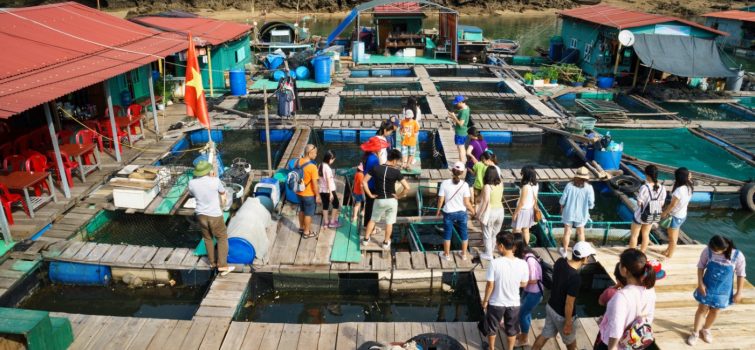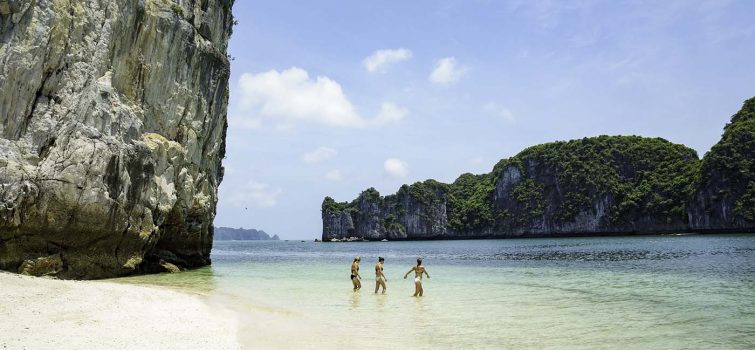Cai Beo Fishing Village in Lan Ha Bay
Lan Ha Bay, in the Cat Ba Archipelago, is covered by nearly 400 limestone mountains and has for centuries been a safe shelter for fishing boats when ferocious storms occur. There are approximately 300 households living in permanent floating villages in the bay and you have the chance to explore the intriguing life in these villages.
Cai Beo fishing village in Lan Ha Bay (commonly known as Lan Ha fishing village) is probably the largest and most famous floating village in Asia, where most people live largely by fishing and fish farming.
Cai Beo fishing village is only about 2km from Cat Ba town and just 10 minutes from Beo seaport. If you join our Heritage Expedition four-day program, you initially travel by van and then take a small boat or our speedboat or tender to visit the village.
Years ago, Lan Ha Bay had about 5,000 households farming Otter Snout clams in floating ponds using plastic baskets, but a disease wiped out the entire population and the fishermen lost their means of earning money and went bankrupt.
The farmers discarded all the baskets used to raise the clams and these sank to the bottom of Lan Ha Bay. Red algae started to grow on the baskets, polluting the water and creating a major problem for the fish living in the waters.
Many fishermen drag their nets across the sea bottom when fishing and some nets are torn by the discarded baskets, so the fishermen continually have to repair their nets. Now these baskets have been retrieved to help clean the water.
Although a fisherman’s life is hard and simple, they appear quite content with their lot in life. They have to start very early and finish very late doing lots of physical work. Fishermen live away from the mainland, but they can buy anything from the hawkers who sell supplies to the villagers from their boats. The fishermen do not have a huge variety of food available to them, like on the mainland, but they can catch fish to feed their families and they just need to buy vegetables, salt and fish sauce.
The scenery here is very beautiful with colorful floating houses nestled in the shelter of the islands, a stone backyard. The fishing village of Beo is spread across 18.000m2. The people who live in the Cai Beo settlement evolved from the Neolithic period and were hunter gatherers right through to the Bronze Age when their civilization evolved to become fishermen and also settled on the land to create agricultural settlements. The first indigenous people in Cai Beo are probably descendants of an ancient civilization from Hoa Binh – Bac Son, from around 12,000 years ago.
In early 2007, a team of specialist scientists undertook extensive excavations and 10 tombs were revealed with 137 stone artifacts and 1,424 pottery shards, all made from granite, ceramic, and twisted rope as well as fish bones, shells and oysters. Analysis indicated that Cai Beo is a site of archaeological importance and was the home of fishermen around 7,000 years ago, who lived mainly from fishing, scallops and oysters, a way of life that continued until around 4,500 years ago.
Guests taking part at Heritage Expeditions (4 days and 3 nights) will have the chance of visiting this unique historical site, and experience this community’s eccentric lifestyle.
The Famous Cat Hai Fish Sauce
If Phu Quoc fish sauce is considered to be the most well-known specialty of Phu Quoc Island (Kien Giang province), then Cat Hai fish sauce is one of the most famous products of Cat Hai Island (Haiphong). It has also been selected as one of Vietnam’s top condiments by the Vietnam Guinness Book of Records.
Fish sauce first appeared in Cat Hai in the 20th century and was originally called Van Van fish sauce. As soon as you set foot on the island, the first thing you will notice is the salty and fragrant smell of fish sauce being produced right across the island.
In the past, people in the north knew Cat Hai fish sauce under the Van Van brand, famous across Indochina because of its quality and rare flavour, with a protein content of around 15-40% per litre. In 1959, it was renamed Cat Hai fish sauce.
For locals, Cat Hai fish sauce is indispensable for the family meal and there is simply no substitute. The characteristic aroma of Cat Hai fish sauce stems from anchovy and squid, or Nham fish, combined with sea salt.
Each year, more than 7 million litres of Cat Hai fish sauce are supplied to the market with over 700 agents and outlets throughout 24 provinces across Vietnam. But it is not only for domestic consumption; Cat Hai fish sauce is also exported to many countries in Asia and to Eastern Europe.
The method of production determines the quality of fish sauce and is still mainly manual. Fish sauce here is made from Ca Com (anchovies) and Nham, a species with a special taste, from the waters surrounding Cat Hai. The fish must be fresh and anything else will ruin the natural flavour of the final product.
The fish is cleaned before being mixed with salt and the mixture, called chướp, is then placed into containers like wooden barrels or concrete tanks. The top layer is pressed down with a bamboo net containing heavy stones. It is very important that “chướp” must be exposed to sunlight and has to be stirred constantly.
“Chướp” is brewed and sun-dried for between 12 and 24 months during the self-ripening process. After that, the fish have naturally reacted with the water and are totally hydrolyzed, yielding the salty, fishy liquid that has a very high protein content and a light amber color. No chemicals are used to create the smell or color.
When visiting Cat Hai, visitors should ensure they take the opportunity to observe the process of making fish sauce and enjoy its delicious taste.
How to Get There?
Cat Ba Island is considered as one of the largest and most visited destinations in the northern of Vietnam, along with Halong Bay. This island is 350 km2 in area and consists of around 367 beautiful islets with diverse sizes creating an imposing scenery and appeal a huge number of tourists annually. Cat Ba Island is separated from the mainland, faces up with East Ocean in the South, surrounded by Halong Bay in the North East and final, in the West covered by Hai Phong City. Therefore, there has been different routes to help you travel to Got Harbour. Transportation and time might be different depending on your itinerary and even the styles of travelling. With an aim to helping tourists have a better information, Heritage Cruises would like to provide you with different means of transportation to reach Got Harbour.
- The closest airport is Cat Bi International (HPH) in Haiphong, it takes 30 mins for you to get to Got Harbour (“Bến Phà Gót” in Vietnamese) to embark on Heritage Cruises. Using aerial transportation to Hai Phong is a smart choice for those who are now in HCM City, Da Nang and Buon Ma Thuot.
- From Noi Bai Airport (HAN) in Hanoi, it takes about one hour and a half by the new expressway to get to Got Harbour (Haiphong).
- Getting on the Seaplane to Tuan Chau Island (Halong City) is also an option, with a 45-min flight. From Tuan Chau, a private car would be necessary to take you to Got Harbour where Heritage Cruises is always present to assist you, approximately 45 mins away.
- At the new Van Don Airport (VDO) in Quang Ninh Province and wanted to visit another destinations that have beautiful landscapes like Halong Bay but still keep its seclusion. Cat Ba Island is something that cannot be missed. Your job is just taking a car on the new highway to get to Got Harbour, about 2 hours.
Getting to Got Harbour by road seems to be the most popular way for tourists in terms of prices and convenience. You can reach Got Harbour from 3 places: Hanoi, Halong Bay and Cat Ba.
1. From Hanoi:
Option 1:
– The travellers can easily take a bus around the Old Quarter which drive them directly to Hai Phong City.
– Operating the new expressway 5B helps cuts down the time traveling to Got Harbour to 1h30 instead of 4 hours. This has removed the main inconvenience of travel to the other regions, which is usually a sinuous and narrow road passing through many villages.
– With desires helping you receive best services, Heritage Cruises offers daily limousine (DCAR) shuttles from Hanoi’s city center to Got Harbour, supplied with Free Wi-Fi, comfortable leather seats and professional drivers. Besides, we might arrange private cars for tourists on demand. It can be seen that the private car tends to be a more affordable and comfortable option compared to a taxi as usual, especially it is recommended for family trip with children.
Option 2:
– Getting onto the coaches (not local public buses) goes directly from Hanoi to Got Harbour. The travel time of Hanoi-Got Harbour journey has been reduced to nearly 2 hours. At Got Harbour, our Heritage Cruises will take you go around and enjoy the incredible beauty that nature endows for Cat Ba Island.
– The advantages of sharing tourist coaches are comfortable, convenient and proper prices, comparative to others. The coach will pick you at your hotel in Hanoi around the Old Quarter and then transfer you directly to Hai Phong City. Therefore, it has no stress on the way in terms of time and luggage stuff with little or no waiting time.
– Here are some details of how to get Got Harbour from Hanoi by coach: + Departure: At hotels around the Old Quarter, 1st Cho Gao Street or 13 Hang Huong, Hang Ma Street, Hanoi.
+ Arrival: Cat Hai, Cat Ba
+ Hanoi – Got Harbour: 7h30; 10h30; 14h
+ Got Harbour – Hanoi: 9h; 12h30; 16h
+ Price: VND 150,000/person
+ Car provider: Good Morning Cat Ba
2. From Halong
– You take a bus or a taxi from Halong City (Quang Ninh Province) to Hai Phong City within 45 mins compared to before. Private cars or taxis are most convenient choice, but public buses are also available. This route is pretty suitable for those who are at Halong City and want to enjoy other destinations.
– Here are some details about how to reach Haiphong from Halong: + Departure: Muong Thanh Hotel at Halong Street, Bai Chay Ward, Halong, Quang Ninh.
+ Arrival: No 19, Nui Ngoc Street, Cat Ba, Hai Phong.
+ Price: VND 120,000/person
3. From Cat Ba:
For those who are already in Cat Ba Island or would like to visit further after the cruise, there is the Got Harbour, departing/arriving from the harbour as Heritage Cruises in Cat Hai (Haiphong), 20 – 30 mins. We recommend a private car as well, since Cat Ba Island is quite large and the distance amongst each destination can be significant.
[/vc_column_text][/vc_tta_section]
Please note that the time might change marginally so check your itinerary carefully before you go. The price for train tickets is also various and depends on whether you’re traveling on the weekend or weekday and choose hard or soft seats.
Here are several details about how to get Got Harbour by train:
+ Departure: Hanoi Railway Station – 120 Le Duan, Hoan Kiem District, Hanoi.
+ Arrival: Haiphong Railway Station – 75 Luong Khanh Thien, Luong Khanh Thien, Ngo Quyen, Haiphong.
+ Time from Hanoi to Haiphong: 06.00, 09.17, 15.20 and 18.15
+ Price: Monday – Thursday: VND 65,000/person for a hard seat;
VND 70,000/person for a soft seat.
Friday – Sunday: VND 75,000/person for a hard seat;
VND 80,000/person for a soft seat.
You’ll get to Got Harbour from Cat Ba Island by ferry. The ferry ticket costs VND 15,000/person through Cai Vieng Port in Cat Ba Island to reach Got Harbour, 20-30 mins, not including the bus to/from the centre of the island.
Apparently, taking a ferry is much cheaper than other ways but it takes much time and is more crowded. You can go to Got Harbour from Cat Ba Island by hydrofoil.
Departing/arriving at Got Harbour, the hydrofoil ticket costs VND 60,000/person to Phu Long Port (“Bến Phù Long” in Vietnamese), not including the bus to/from the centre of the island. After 8-10 mins journey, you will be at Got Harbour. Obviously, the time for transfering is quite fast so tourists who are seasick shouldn’t use this vehicle.
Option 1:
Firstly, you can depart at Tuan Chau Island (Halong City) by taking a private speed boat to Gia Luan Harbour (25 kms far from Cat Ba Town), 20 mins to get there. Then, taking a taxi to get to Cai Vieng Port. Finally, you can get to Got Harbour through Cai Vieng Port. Time and price are presented above, in the 4th part.
– Here are several departure times:
+ Tuan Chau Island to Gia Luan: 7h15; 8h30; 10h30; 13h; 14h30; 16h
+ Gia Luan to Tuan Chau Island: 8h; 9h15; 11h; 13h; 15h30; 16h30
+ Price: VND 450,000 for less than 9 people
VND 650,000 for 9 to 16 people
Option 2:
– Departure from Hon Gai Port (Halong City) to get Got Harbour is properly the second choice for you. The only thing that you have to do is take the speed boat and go directly to Beo Seaport, 1,5 km far from Cat Ba Town. It takes about 40 – 45 mins on boat.
– From Beo Seaport, you can reach Got Harbour via Cai Vieng Port. The information about price and time is shown in the 4th part – how to get Got Harbour by ferry.
– Here are departure times:
+ Hon Gai Port – Beo Harbour: 7h30; 13h
+ Beo Harbour – Hon Gai Port: 8h30; 13h55
+ Price: VND 150,000/person
Please note it down, the times for departure may change without notification. Make sure that you contact with service providers before your comings. Obviously, the speed boat is more convenient and time-saving for you, especially in high season. In a urgent situation, Heritage Cruises can help you to book a private speedboat to get Got Harbour on time for boarding on our cruise.
In conclusion, Heritage Cruises has just helped you to look through all the possible routes from your home country, Hanoi city, Halong Bay, Hai Phong city or Cat Ba Town to get Cat Ba Island by different means of transportation. Each route has own its advantages and disadvantages, travellers should take into account to choose the way, vehicles and the budget that are appropriate with your itinerary and present condition. If you need more detailed information, please don’t hesitate to contact us.
About the Cat Ba Archipelago & Lan Ha Bay
Authenticity is the buzzword for Cat Ba Archipelago and Lan Ha Bay. Traveling to Cat Ba by road only takes 1.5 hours from Hanoi by the 5B Highway. Nowadays, travelers are switching from Halong Bay to Cat Ba and Lan Ha Bay in increasing numbers.
This place is now firmly in the development phase; everything is just getting started. Lan Ha is so small that you can rent a cruise boat to explore the bay by yourself. This is perfect for Cat Ba’s based travelers who are self-confident and experienced and want a whole new kind of adventure.
Cat Ba is the largest of the 366 islands spanning the 260km2 that comprise the Cat Ba Archipelago, which makes up the southeastern edge of Halong Bay in Northern Vietnam.
Cat Ba island has a surface area of 285km2 and retains the dramatic and rugged features of Halong Bay. This island belongs to Haiphong City – an important industrial city which, together with Hanoi and Halong, forms an important economic triangle in North Vietnam.
Approximately half of Cat Ba Island is covered by a national park, which is home to the highly endangered Cat Ba Langur.
The island has a wide variety of natural ecosystems, both marine and terrestrial, leading to incredibly high rates of biodiversity.
The types of natural habitats to be found in the Cat Ba Archipelago include limestone karsts, tropical limestone forests, coral reefs, mangrove and sea-grass beds, lagoons, beaches, caves, and willow swamp forests.
Cat Ba island is one of the only populated islands in Halong Bay, with roughly 13,000 inhabitants living in six different communes, and 4,000 more inhabitants living on floating fishing villages off the coast.

The majority of the population can be found in Cat Ba town, which is located at the southern tip of the island (15km south of the national park) and is the commercial center. Cat Ba’s fish sauce is particularly famous and one of the main industries on the island and travelers can visit the factory in Cat Ba town.
Halong Bay is understandably popular and crowded, but if you want to experience it without other tourists, be sure to book our private charter boat that will sail where you want, cruising on your own itinerary.
Go deep into the bay, explore the caves and grottoes, head over to Bai Tu Long Bay and Lan Ha Bay, trek in Cat Ba National Park, go rock climbing, kayaking, and watching some of the most amazing sunsets that you’ll ever set eyes on.
Heritage Cruises can help you to take up his challenge with three experiences: Dream Cruise for one day, Discover Cruise for two days, Explorer Cruise for three days and Expedition Cruise for four days. In addition, we arrange private charters for four or five day expeditions in the Gulf of Tonkin.
Discover Dong Hoa Cuong or Diamond Cave
Cat Ba Island is one of the main destinations of the Halong region. The island is famous for its many caves, both small and large, and prominent among them are Quan Y (historic Hospital Cave), Trung Trang, Dong Hoa Cuong and Thien Long caves, all with numerous impressive stalactites and stalagmites. Dong Hoa Cuong, or Diamond Cave, is one of the most amazing caves and you should make a point of seeing it if you join our Heritage Expedition four-day program.
Close to the village of Gia Luan one of the most beautiful and famous caves of the Cat Ba Islands, Hoa Cuong cave or Da Hoa cave, can be found. It has been named Hoa Cuong (Diamond) cave because of the interior’s iridescent sparkle, just like a diamond. The cave is located in a large mountain to the northeast of the village, at an altitude of 50 metres above sea level and 10 metres in height.
Reached through a large arched entrance, hidden by trees and bushes, the cave is wide and quiet, 25 metres in width and 100 metres long, with a pleasant temperature, perfect for a visit. In the Diamond Cave, there are many stalactites created in a variety of shapes by Mother Nature, many taking on the appearance of humans and animals. On the right-hand side of the cave is a giant curtain of stalactites, which inspired a local legend.
According to the legend, the King of Heaven found the climate here idyllic and the scenery charming, so he would take the princes and princesses to spend time together here in the cave. The stalactite curtain separated the boudoir of one of the princesses, guarded by two stone lions, where the princess rocked her baby to sleep on a magnificent bed, accompanied by a small fairy.
As you explore further into the cave you come across a luminous cool lake, the water so clear that you can see the white pebbles at the bottom. The people of Gia Luan believe that the women in this region have white skin as a result of bathing in the lake. Close by is a rock that looks like a boat belonging to a prince, giving the lake a romantic feeling and perpetuating the legend of the cave. When light floods into the cave, the lake shimmers and the reflections on the stalactites and stalagmites appear to be like flowers blooming, creating a sense of magic.
Archaeologists have excavated here and discovered the fossilized teeth of an ancient gibbon dating back tens of thousands of years, clearly demonstrating the existence of an ancient gibbon species living in Cat Ba Island.
Hoa Cuong cave is a particular favorite of both domestic and foreign visitors because of the pristine beauty of the area, the legends surrounding it, and the fascinating history revealed by the archaeologists. One not to be missed!





